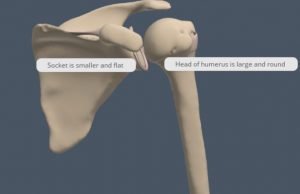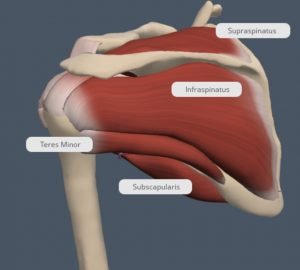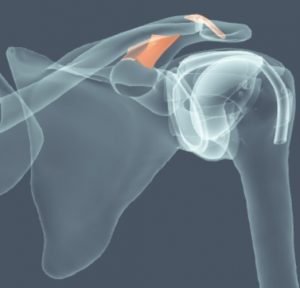Can physio help shoulder pain?
Are you experiencing shoulder pain? It’s funny how we don’t notice how often we need to raise our arms during daily living until it hurts to do so! Don’t despair, in most cases of shoulder pain, physiotherapy will be able to provide relief. Shoulder pain which comes on slowly over a period of time is often caused by a mechanical issue in the shoulder (how it is moving) resulting in impingement rather than a structural issue. Other types of shoulder injuries you may have heard of rotator cuff injuries, shoulder dislocations, AC joint injuries and arthritis. Physio can help with all of these issues.
A quick anatomy lesson…
 The shoulder joint looks a little like a golf ball resting on a tee. This lack of bony congruency allows us the large range of motion required at our shoulders to participate in activities such as swimming, throwing and dancing, but comes at the price of sacrificing some of the stability around the joint. When we lift our arm up, the big deltoid muscle pulls up on the top of the arm bone, which would essentially bump it into the top of the joint if our rotator cuff muscles did not switch on to hold it in the centre. How well these rotator cuff muscles work is dependent upon the position of the shoulder blade, so the muscles which control the shoulder blade are important too.
The shoulder joint looks a little like a golf ball resting on a tee. This lack of bony congruency allows us the large range of motion required at our shoulders to participate in activities such as swimming, throwing and dancing, but comes at the price of sacrificing some of the stability around the joint. When we lift our arm up, the big deltoid muscle pulls up on the top of the arm bone, which would essentially bump it into the top of the joint if our rotator cuff muscles did not switch on to hold it in the centre. How well these rotator cuff muscles work is dependent upon the position of the shoulder blade, so the muscles which control the shoulder blade are important too.
What is the rotator cuff?
The rotator cuff is a group of four muscles (supraspinatus, infraspinatus, subscapularis and teres minor), which work as a team to keep the arm bone centred in the socket when we use our arm. If there is an injury to one of more of the rotator cuff muscles or tendons (the bit which attaches a muscle to a bone), then this can affect the function of the shoulder. However, the good news is, as there are four muscles in the group, you can train the uninjured muscles to increase their workload to take the pressure off the injured area, resulting in pain-free activity.
Impingement
Impingement is one of the most common causes of shoulder pain and generally occurs when the arm bone rides up in the socket with movement and pinches the structures at the top of the socket. This can occur after a small injury to the shoulder, fatigue of the muscles or imbalance of the muscles around the joint. The pain provoked by this pinching can cause the muscles to switch off further, increasing the likelihood of painful symptoms. Physio can identify which of your muscles are tight, weak or underactive, and with a combination of massage, stretching, taping and exercises, restore your shoulder’s normal, pain-free motion.
Rotator cuff injuries
You have had a scan and been told you have a rotator cuff tear – what next? It is useful to know that rotator cuff tears are considered a normal part of the shoulder aging, with all studies conducted in this field suggesting there is a steady increase in the incidence of rotator cuff tears once a patient reaches 50. However, if the scan was performed after a recent accident or injury and indicates a large, acute tear in the rotator cuff, it is definitely worth consulting a shoulder surgeon as to your best management plan moving forwards. However, if you have to wait to see the surgeon, or if your shoulder pain was not the result of a specific incident, then physiotherapy is the way to go.
Traumatic injuries
Shoulder dislocations
With the nationwide popularity of contact sports, it an unfortunate inevitability that shoulder dislocations will occur. They are the most common joint dislocation presenting to sports clinics. When a dislocation occurs, the structures around the shoulder are bruised and stretched. These structures need to be allowed to heal, but it is very important to get the muscles around the shoulder working immediately to help support the joint. Whether or not you need surgery, physiotherapy is an integral part of retraining these muscles to facilitate return of function.
The AC joint refers to the acromioclavicular joint and it is where the shoulder blade attaches to the collar bone, the only joint attaching the arm to the body. This joint is generally injured by a direct fall onto the shoulder and can be seen as a bump on the top of the shoulder. Severe injuries may require surgery to stabilise the joint, but minor-moderate injuries are treated by physiotherapy, which is aimed at reducing pain and swelling and increasing strength and stability around the joint.
Shoulder arthritis
As we start to get a few grey hairs on our head, we start to get a few ‘grey hairs’ in our joints as well. Arthritis is a normal part of an ageing joint, but when it becomes painful, it becomes a problem. The aims of physio for shoulder arthritis are to maintain mobility and strength around the joint in order to minimise pain and improve function. Like knees and hips, shoulder replacements can be performed to provide a brand new joint surface, but obviously, we would like to delay this major surgery for as long as possible!
Overall, physio can be a very effective treatment for shoulder pain and at the very least, your physio will be able to perform a thorough assessment and give you advice regarding the best management moving forwards. Please feel free to contact our team at reception to organise an appointment.
Author: Annabel Hawker


